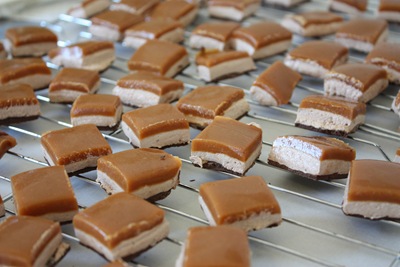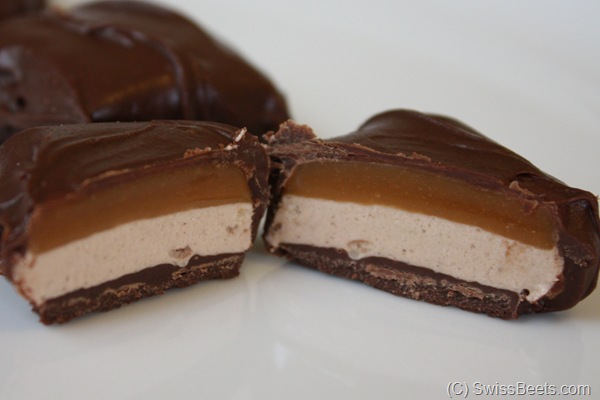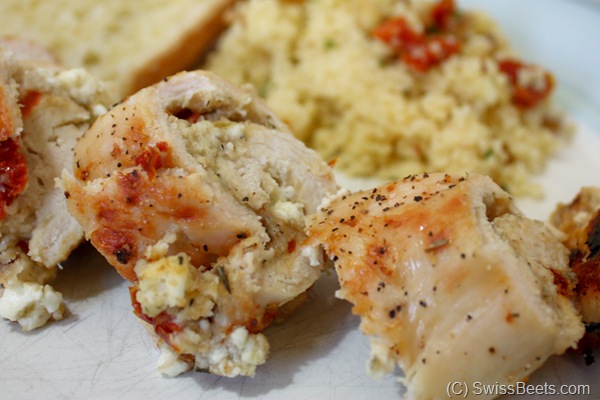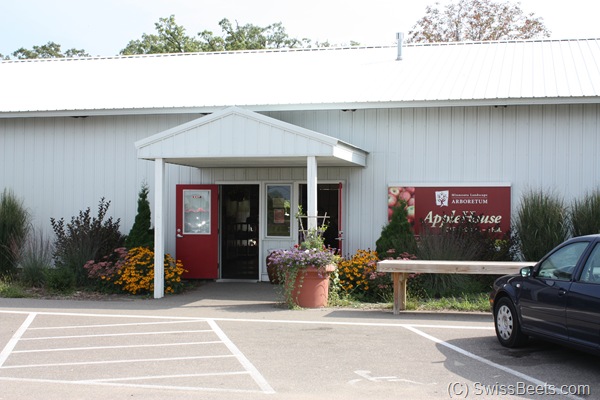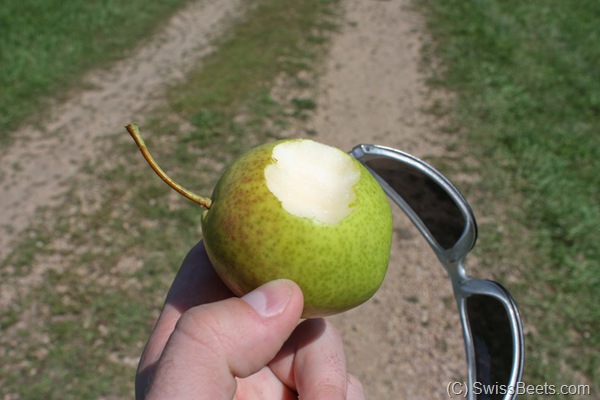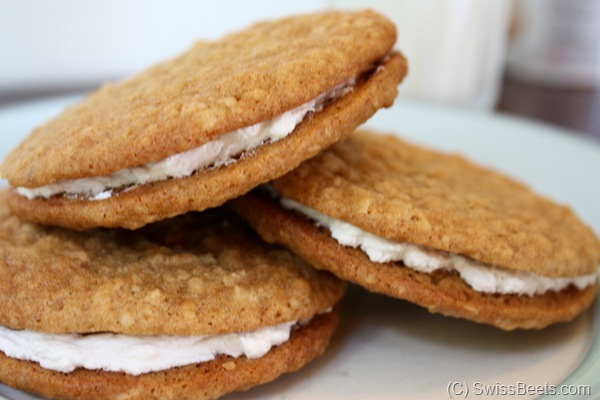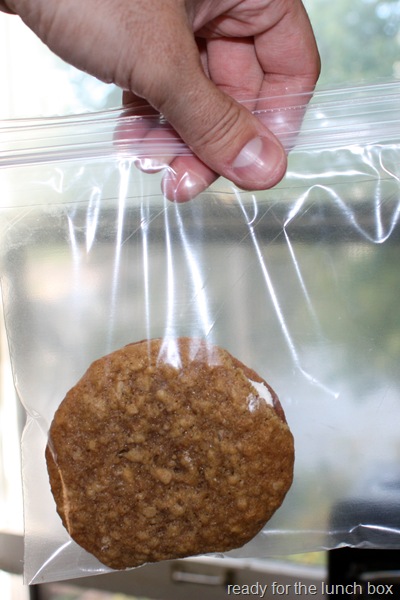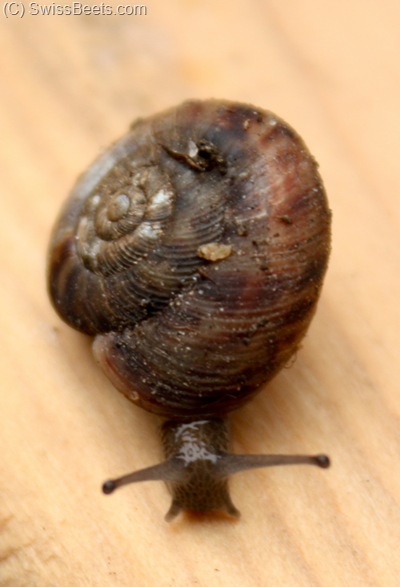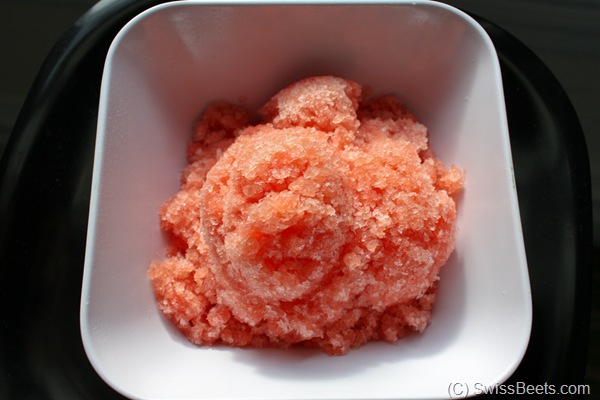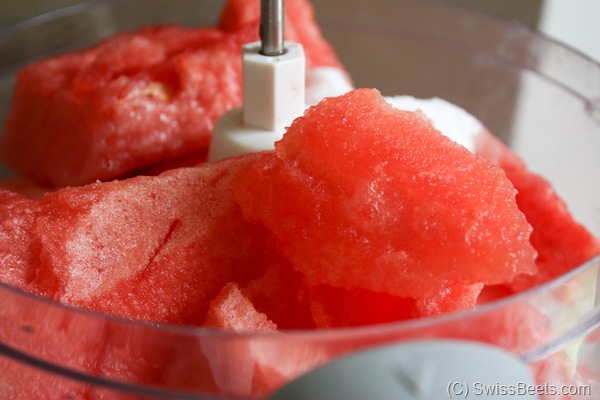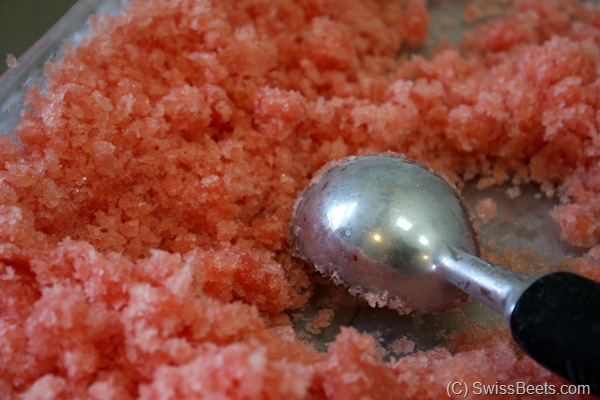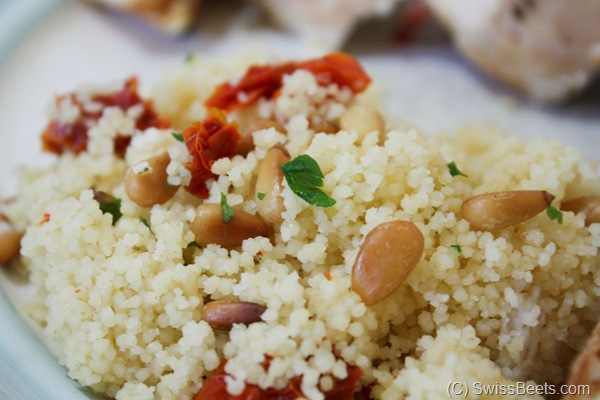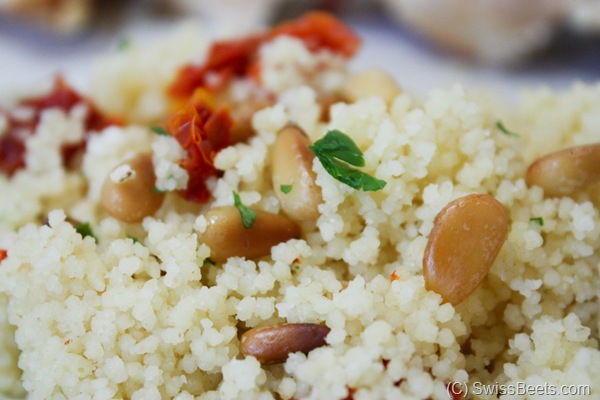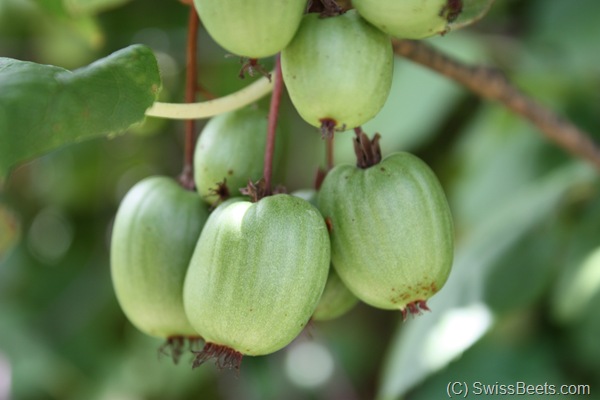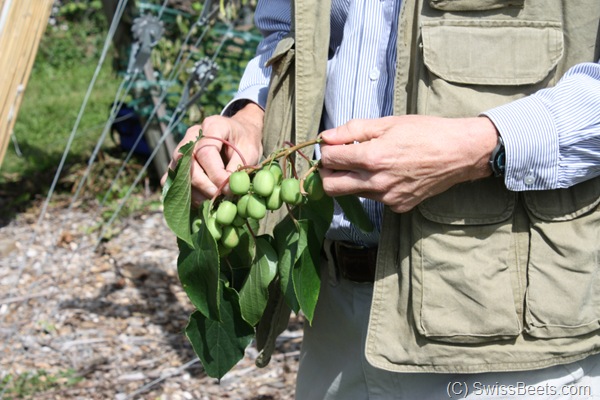 I traveled about 45 minutes from my home in St. Paul to the Apple House at the University of Minnesota Horticultural Research Center near Victoria, Minnesota. The big, metal building among rolling farmland and new home developments, reminded me of a barn. Instead of hay and horses, however, you can buy plants, gardening guides, fresh vegetables and of course apples.
I traveled about 45 minutes from my home in St. Paul to the Apple House at the University of Minnesota Horticultural Research Center near Victoria, Minnesota. The big, metal building among rolling farmland and new home developments, reminded me of a barn. Instead of hay and horses, however, you can buy plants, gardening guides, fresh vegetables and of course apples.

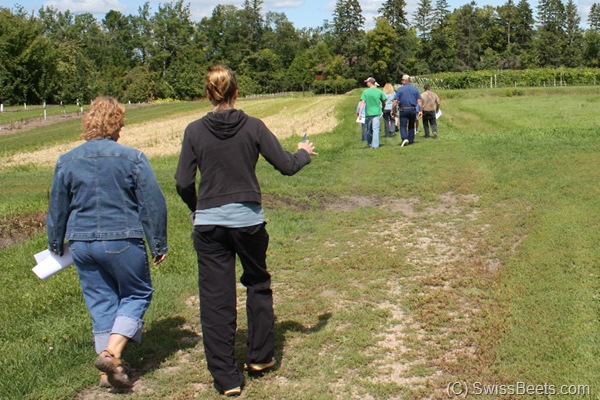 A group of about 25 of us met outside the Apple House. Our group ranged from people with a general interest in growing kiwi in their backyard to farmers looking for a new crop. We began our trek across the busy highway to the testing orchard. There, they grow different varieties of pears, apples, grapes and now kiwis to see what’s marketable and what can grow in Minnesota’s climate. The discoveries here will help local farmers find new crops to benefit themselves, consumers, and the environment.
A group of about 25 of us met outside the Apple House. Our group ranged from people with a general interest in growing kiwi in their backyard to farmers looking for a new crop. We began our trek across the busy highway to the testing orchard. There, they grow different varieties of pears, apples, grapes and now kiwis to see what’s marketable and what can grow in Minnesota’s climate. The discoveries here will help local farmers find new crops to benefit themselves, consumers, and the environment.
 Our tour guide was U of M's kiwi curator, Bob Guthrie. Pictured above, he’s using a refractometer to test the sweetness of one of the kiwifruits. Guthrie plants and tests kiwi plants at the U-of-M’s orchards and at his home in Roseville, MN. He’s part Bill Nye the Science Guy and your favorite high school science teacher. He has the passion and eagerness to share his knowledge about kiwis, and passed on tips to grow them at home. For example, kiwis need male and female plants to bear fruit. One male plant should help pollinate seven to eight females. We also learned kiwis are easily grown from cuttings. Guthrie even offered a visitor cuttings for free, even though they were ready to pay.
Our tour guide was U of M's kiwi curator, Bob Guthrie. Pictured above, he’s using a refractometer to test the sweetness of one of the kiwifruits. Guthrie plants and tests kiwi plants at the U-of-M’s orchards and at his home in Roseville, MN. He’s part Bill Nye the Science Guy and your favorite high school science teacher. He has the passion and eagerness to share his knowledge about kiwis, and passed on tips to grow them at home. For example, kiwis need male and female plants to bear fruit. One male plant should help pollinate seven to eight females. We also learned kiwis are easily grown from cuttings. Guthrie even offered a visitor cuttings for free, even though they were ready to pay.
 Once inside the orchard’s border of fencing and shrubs, we walked to the far edge and there, alongside grapes, we spotted the first row of kiwis. Now these aren’t the fuzzy kiwi you’d find in the supermarket. These are about the size of large grapes, with green, edible skin and they’re quite a treat. Many of the fruits still attached to the vine were hard. The ripe ones had the feel and give of a grape when slightly pressed between your finger and thumb. As we walked down the row, we were encouraged to give the vines a little shake. If a few kiwis fell off, then they were likely the most ripe and ready to eat.
Once inside the orchard’s border of fencing and shrubs, we walked to the far edge and there, alongside grapes, we spotted the first row of kiwis. Now these aren’t the fuzzy kiwi you’d find in the supermarket. These are about the size of large grapes, with green, edible skin and they’re quite a treat. Many of the fruits still attached to the vine were hard. The ripe ones had the feel and give of a grape when slightly pressed between your finger and thumb. As we walked down the row, we were encouraged to give the vines a little shake. If a few kiwis fell off, then they were likely the most ripe and ready to eat.
 Pictured above, it looks like a perfect mini kiwi. Each one seemed to have their own flavor. Some were really sweet, others tasted like an apple, and yet others tasted just like mini kiwis. I was surprised to learn, they can be dried like raisins and even made into wine. These are other options for farmers whose kiwis may not be the best looking for fresh-eating.
Pictured above, it looks like a perfect mini kiwi. Each one seemed to have their own flavor. Some were really sweet, others tasted like an apple, and yet others tasted just like mini kiwis. I was surprised to learn, they can be dried like raisins and even made into wine. These are other options for farmers whose kiwis may not be the best looking for fresh-eating.
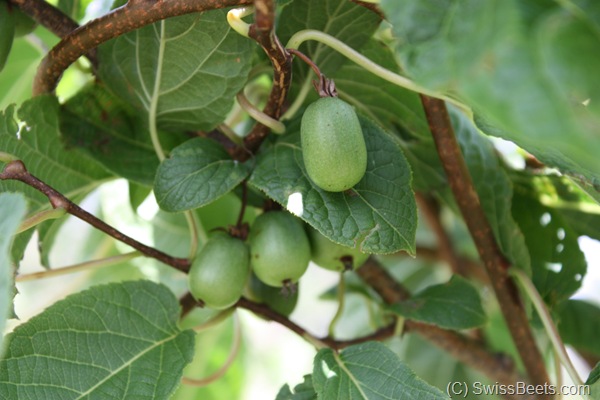 The first rows we toured were the oldest of the test beds and they’re not in a spot that is conducive for growing kiwi. First, they were situated East-West. Apparently the plants are best situated North-South. This will help prevent sun burn on their vines and will allow them to shade themselves from the elements.
The first rows we toured were the oldest of the test beds and they’re not in a spot that is conducive for growing kiwi. First, they were situated East-West. Apparently the plants are best situated North-South. This will help prevent sun burn on their vines and will allow them to shade themselves from the elements.
Second, kiwifruit likes part shade. New homes had been built that destroyed the forest and therefore destroyed the kiwifruit’s shade and protection. To conquer that, their newest system for testing, is a somewhat elaborate, wire pergola.
 Kiwis grow on vines that climb quite vigorously. This pergola system will give the kiwis shade, allow easy harvest and abundant room to spread out and make its own canopy. The pergola is also situated North-South so they’ll be able to test their own suggestions at growing kiwi successfully in colder climates. Most hardy kiwis are able to grow in zones 4-9, but ‘Arctic Beauty’ can grow in zone 3. Researchers recommend a thick layer of woodchips that not only protects the roots at winter, but it also helps keep in moisture during the summer. The result is a much denser and extensive root system, which will help in the growing season.
Kiwis grow on vines that climb quite vigorously. This pergola system will give the kiwis shade, allow easy harvest and abundant room to spread out and make its own canopy. The pergola is also situated North-South so they’ll be able to test their own suggestions at growing kiwi successfully in colder climates. Most hardy kiwis are able to grow in zones 4-9, but ‘Arctic Beauty’ can grow in zone 3. Researchers recommend a thick layer of woodchips that not only protects the roots at winter, but it also helps keep in moisture during the summer. The result is a much denser and extensive root system, which will help in the growing season.
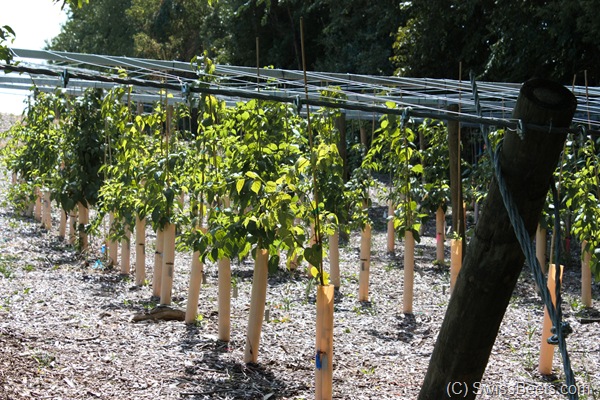

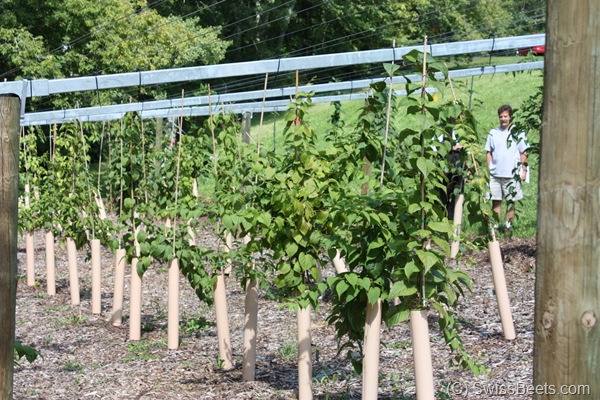
 This pergola is so high, that it’ll make harvesting a breeze, as the fruit hang down for picking.
This pergola is so high, that it’ll make harvesting a breeze, as the fruit hang down for picking.

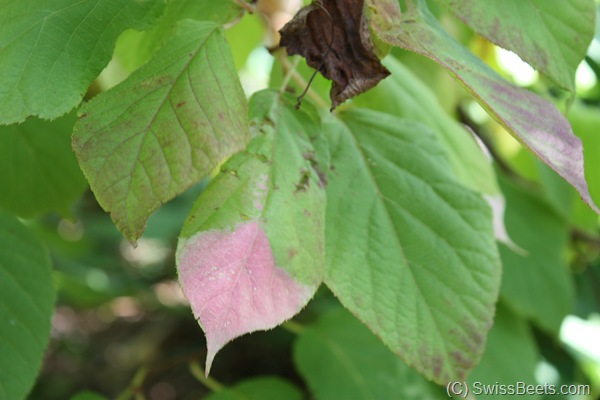 The pink-tinged leaf above is from the kiwi called “Arctic Beauty.” In the springtime nearly all the leaves have pink on their tips. This variety can be found in many garden catalogs. It’s hardy to zone 3, hence the ‘Arctic Beauty’ name.
The pink-tinged leaf above is from the kiwi called “Arctic Beauty.” In the springtime nearly all the leaves have pink on their tips. This variety can be found in many garden catalogs. It’s hardy to zone 3, hence the ‘Arctic Beauty’ name.
 Pictured above is the kiwi called Silver Vine. This is perhaps the only hardy kiwi that changes color once ripe. It’ll turn a golden color when ready for picking, but it’ll also attract Robins.
Pictured above is the kiwi called Silver Vine. This is perhaps the only hardy kiwi that changes color once ripe. It’ll turn a golden color when ready for picking, but it’ll also attract Robins.
 This is one of their hybrid crosses. It’s 3/4 hardy kiwi, and 1/4 fuzzy golden kiwi. You can already see the drastic size difference in leaves as compared to the regular hardy kiwis. I believe this cross has already survived one winter. Since it’s male, they don’t know how big the the fruits will be until they can get a female ready to produce.
This is one of their hybrid crosses. It’s 3/4 hardy kiwi, and 1/4 fuzzy golden kiwi. You can already see the drastic size difference in leaves as compared to the regular hardy kiwis. I believe this cross has already survived one winter. Since it’s male, they don’t know how big the the fruits will be until they can get a female ready to produce.
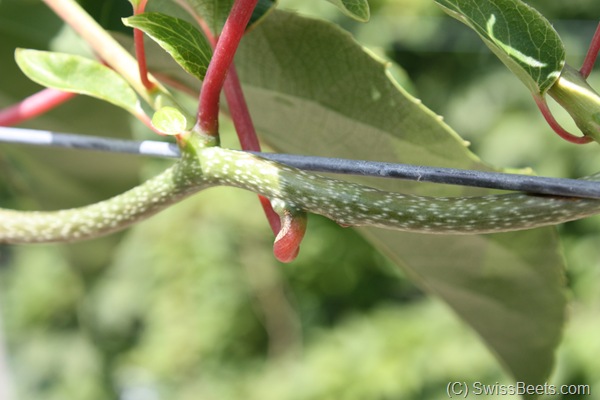 A tropical expression of foliage that does quite well in negative zero winters.
A tropical expression of foliage that does quite well in negative zero winters.
 Above is a kiwi vine that’s being trained along a wire T-bar system similar to grapes. Researchers believe their pergola system is better suited for growing kiwifruit however.
Above is a kiwi vine that’s being trained along a wire T-bar system similar to grapes. Researchers believe their pergola system is better suited for growing kiwifruit however.
 Everyone was eager to taste these little fruits. You may spot them in the grocery store occasionally, but it sounds like a few more people are ready to grow their own. You may even want to try them in your garden.
Everyone was eager to taste these little fruits. You may spot them in the grocery store occasionally, but it sounds like a few more people are ready to grow their own. You may even want to try them in your garden.
Technorati Tags:
kiwi,
hardy,
orchard,
u of m,
university of minnesota,
hardy kiwi,
arctic beauty,
minnesota,
fruit,
growing,
plants,
garden,
how to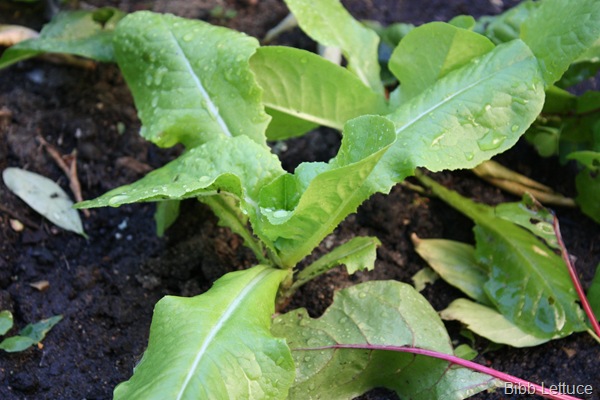 Make no mistake about it, fall has arrived in Minnesota. The lows are dipping into the 40’s here in Saint Paul, and my fall garden is running behind.
Make no mistake about it, fall has arrived in Minnesota. The lows are dipping into the 40’s here in Saint Paul, and my fall garden is running behind. 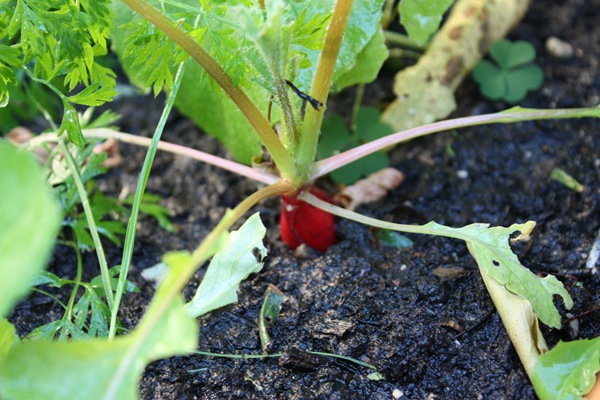 One good thing I learned from this fall bed, is which radish and which lettuce seem to be the most hardy. Out of the easter egg blend radish packet, only the white globe radish has managed to bulb out. The red radish pictured above is just starting to bulb however. And from the lettuce sampler seed packet, only the bibb lettuce is still standing.
One good thing I learned from this fall bed, is which radish and which lettuce seem to be the most hardy. Out of the easter egg blend radish packet, only the white globe radish has managed to bulb out. The red radish pictured above is just starting to bulb however. And from the lettuce sampler seed packet, only the bibb lettuce is still standing.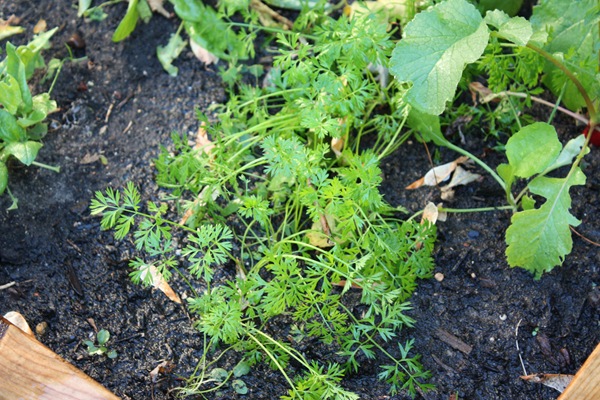 The Little Finger Carrots are growing well but they need to get bigger roots to harvest. The kohlrabi is doing so-so, but I’m not sure they’ll bulb out before the big freeze. Speaking of which, the metro is under a frost advisory, but the garden should be OK. My plantings are cool weather crops and I think it’ll stay frost free. Stay tuned.
The Little Finger Carrots are growing well but they need to get bigger roots to harvest. The kohlrabi is doing so-so, but I’m not sure they’ll bulb out before the big freeze. Speaking of which, the metro is under a frost advisory, but the garden should be OK. My plantings are cool weather crops and I think it’ll stay frost free. Stay tuned.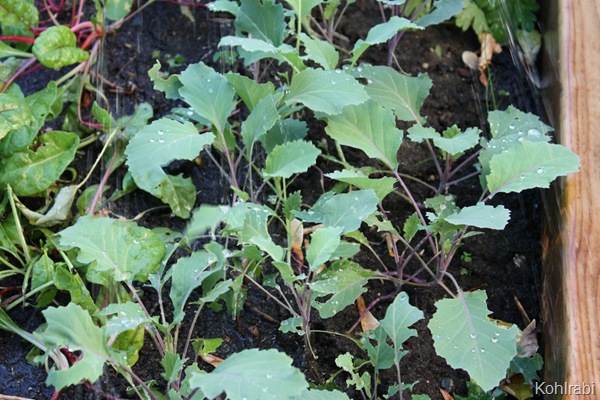

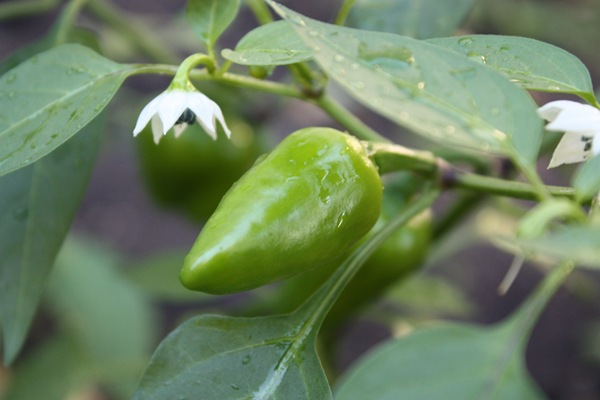 This pepper was grown from seed. It looks like a jalapeno, but another on the same plant looks like a baby bell pepper. I’ll be tasting them before it gets too cold.
This pepper was grown from seed. It looks like a jalapeno, but another on the same plant looks like a baby bell pepper. I’ll be tasting them before it gets too cold.

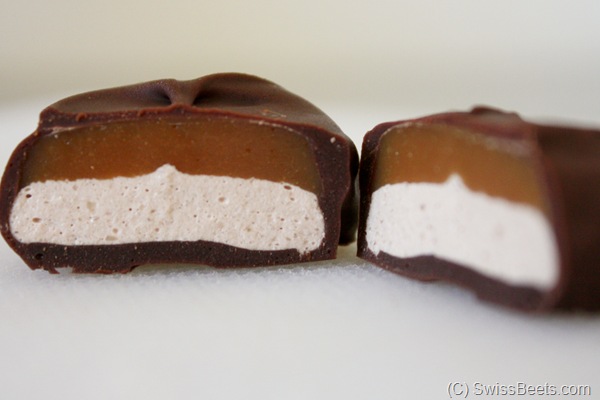 I apologize for being a day late with my blog post. Either the chilly fall wind kicked up a sinus headache, or I ate way too many of these things. They’re rather addictive.
I apologize for being a day late with my blog post. Either the chilly fall wind kicked up a sinus headache, or I ate way too many of these things. They’re rather addictive.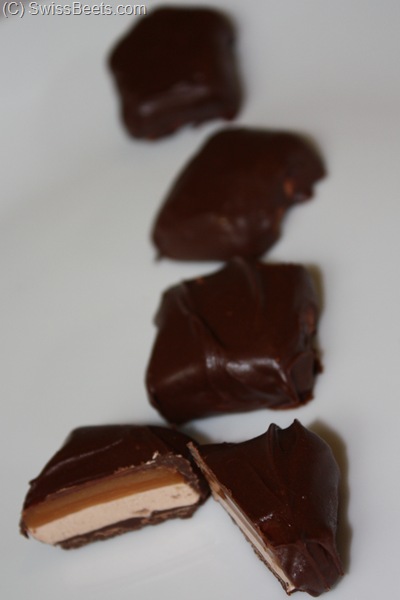 The Milky Way candy bar was introduced in 1923 and was inspired by the popular chocolate malt milkshakes that were popular at that time. For this recipe, I used Carnation chocolate malt mix for the nougat. Real nougat recipes are not necessarily complicated but they are time consuming. However, this nougat is really simple because the marshmallow creme gives it that fluffy texture without all the extra effort.
The Milky Way candy bar was introduced in 1923 and was inspired by the popular chocolate malt milkshakes that were popular at that time. For this recipe, I used Carnation chocolate malt mix for the nougat. Real nougat recipes are not necessarily complicated but they are time consuming. However, this nougat is really simple because the marshmallow creme gives it that fluffy texture without all the extra effort.



